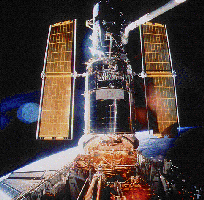

Research Opportunities for Students, Teachers, and Amateur
Astronomers
(Fresno State
Physics)
Campus Observatory Equipment:
The Campus Observatory is on the grounds of the Downing Planetarium, at
longitude 119.7447 degrees West, latitude 36.8147 degrees North, and
elevation 398 feet (121 m). (The local mean time correction is +1m 01.3s.)
Its 16-inch
telescope has a nominal Schmidt-Cassegrain focus at f/10, but most of
our imaging is done at f/6.3
with a Celestron focal reducer. An Optec Temperature-Compensating
Focuser (TCF) is normally left on the telescope all the time. For a
fuller description of the instruments listed below and a description of
current science programs, see here.
Current instruments include:
Filters include:
Other equipment includes:
an
SBIG CFW-8A color filter wheel,
eyepieces (Pentax
XW 14-mm, Tele Vue
Ploessls ranging from 55 mm to 8 mm, and an Orion Ultrascopic
5mm illuminated reticle eyepiece),
Barlow lenses (a TeleVue 2x BIG Barlow
lens, an
Orion 2-3x variable Barlow lens, an
Orion 2x "Shorty" Barlow lens),
two PADC-V4H Planetary Atmospheric
Dispersion Correctors with four-degree prisms,
an eyepiece projection system (constructed by Greg Morgan) that can
reach f/60,
adaptors, 1.25" and 2" diagonals, and balance weights.
Despite being on campus (and convenient for students to use), the 16-inch
telescope can detect stars over 2 million times fainter than the unaided
eye can see (19th magnitude), in 7-second exposures. The 16-inch
telescope's image resolution is between 2-3" for over 80% of the time.
The dome's small 3-m diameter, unpainted aluminum skin, fans inside the
dome, and being surrounded by grass all help its thermal properties.
With the Celestron focal reducer at f/6.3 (the nominal deep-sky imaging
setup), the ST-9XE camera has an image scale of 1.61"/pixel, and gets a
field of view of 13.8' x 13.8'.
(More precisely, the ST-9XE camera at f/6.3 and with no filter can detect
stars with V = 19 at S/N = 5 in 7 s, in an urban sky with no Moon and V =
3 stars visible to the unaided eye, rating 10 on the Bortle scale. The
ST-7XE can reach V = 13.3 at S/N = 60 in a single 30s exposure, so it's
about 1/6 as sensitive as the ST-9XE. This makes sense, since the
ST-9XE's dark count is 4 times lower, and its quantum efficiency is about
50% higher. The ST-7XE is about twice as sensitive as the ST-8, although
it covers only 1/4 as much area as the ST-8. The ST-7XE has 1/3 as much
area as the ST-9XE, which is why the ST-9XE is now the primary imaging
camera, the ST-7XE is dedicated to spectroscopy, and the old ST-8 is a
backup and autoguider.)
Go to Dr. Ringwald's page on Research
Opportunities
for Students, Teachers, and Amateur Astronomers
Last updated 2006 July 29. Web page by Dr. Ringwald
(ringwald[at]csufresno.edu and replace [at] with @)
Department of Physics,
California State University,
Fresno. Please read this disclaimer


